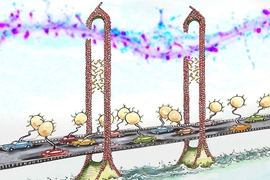A new study from the Picower Institute for Learning and Memory in the Feb. 4 online edition of Neuron sheds light on the innate plasticity of the adult brain at its most fundamental level — the synapse.
Neuron-to-neuron communication that allows the brain to coordinate activity and store new information takes place at synapses. If an outside stimulus doesn’t enact a synaptic change, it doesn’t register — no learning or memory formation takes place. Synapses can be strengthened or weakened, or even added and eliminated in response to new information. Synaptic malfunctions are implicated in certain diseases. A better understanding of how synapses are formed and dismantled in response to external stimuli can help address a wide range of disorders from drug addiction to mental illness.
“The key to enabling plasticity in the adult brain is understanding which elements of a brain circuit are changeable and which aren’t, and under what circumstances,” says study author Elly Nedivi, Picower researcher and professor of neuroscience in the MIT Department of Brain and Cognitive Sciences. “The good news is that while parts of the circuit are hard-wired, others are not — they retain a capacity for remodeling.”
Gaining and losing connections
A neuron is bombarded with signals from hundreds of presynaptic partners. Synapses act as conduits for these incoming signals. Excitatory neurotransmitters flow from the presynaptic to the postsynaptic neuron at synaptic locations that are on bulbous protrusions with a rounded head and thin neck, termed spines. The long branching dendrites of a single neuron can display hundreds of spines like leaves on a tree branch.
When spines appear and disappear, a neuron can gain new connections or lose existing ones. "If spines disappear, they rarely come back to the same location; new spines seek out alternative locations," says biology graduate student Katherine Villa, co-first author on the study. "It’s as if after deciding that a connection is not worth keeping neurons will try to replace it with a different contact."
Seeing spines at work
Using cutting-edge imaging techniques developed in collaboration with Peter So, MIT professor of mechanical and biological engineering, Nedivi’s team tracked the daily dynamics of all the dendritic spines on a single neuron in the living mouse brain, as well as all the excitatory and inhibitory synapses on these neurons. The ability to label inhibitory synapses in live animals is fairly recent; even today, it is notoriously difficult to witness excitatory and inhibitory synapses working side by side.
Directly visualizing inhibitory synapses revealed the surprising fact that while many reside on the shaft of dendritic branches, approximately 30 percent reside on dendritic spines alongside excitatory synapses. Another surprise was that when inhibitory synapses are removed, they return again and again to the same location. “Clearly, the goal here is not to change partners as we see for excitatory connections,” says biology graduate student Kalen Berry, Villa’s co-first author. “We think that inhibitory synapses can act as a kind of gatekeeper, flickering on and off to shut down excitatory connections as needed.”
Interestingly, the dual-purpose spines are large and extremely stable, as are the excitatory connections onto them. “This is essentially a hard-wired part of the circuit,” Nedivi says. “But we still have the potential to modify it via the nearby inhibitory synapse.”
These findings raise questions about why some excitatory connections on singly innervated spines can be restructured while those on dually innervated spines cannot. How does the structural plasticity of inhibitory synapses alter excitatory circuit properties, and what enables their rapid insertion and removal at stable sites? The answers to these questions could shed light on ways to enhance plasticity in the adult brain and synapse-related disorders.
This work was supported by the National Eye Institute.









